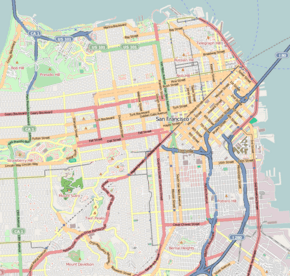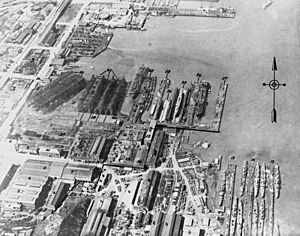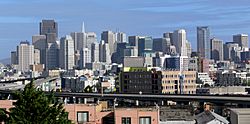Potrero Hill facts for kids
Quick facts for kids
Potrero Hill
|
|
|---|---|
| Country | |
| State | |
| City-county | San Francisco |
| Named for | potrero nuevo (new pasture) |
| Area | |
| • Total | 1.52 sq mi (3.9 km2) |
| Population | |
| • Total | 14,102 |
| • Density | 9,278/sq mi (3,582/km2) |
| Time zone | UTC−8 (Pacific) |
| • Summer (DST) | UTC−7 (PDT) |
| ZIP Codes |
94107, 94110, 94124
|
| Area codes | 415/628 |
Potrero Hill is a lively neighborhood in San Francisco, California. It's a great place to live, known for its beautiful views and friendly community. While it used to be a neighborhood for working-class families, it has changed over time and is now home to many different people.
Contents
- Where is Potrero Hill Located?
- What Makes Potrero Hill Special?
- A Look Back at Potrero Hill's History
- How Potrero Hill Got Its Name
- The De Haro Family and the Land
- Building Streets During the Gold Rush
- Industry and New Residents
- The Long Bridge Connects Potrero Hill
- European Immigrants Arrive
- Potrero Hill Grows as Dogpatch Industrializes
- Freeways and Southern Development
- A Hub for Artists and the LGBT Community
- The Dot-Com Era and Changes
- Potrero Hill Today
- Fun Things to Do in Potrero Hill
- Living in Potrero Hill
- Schools in Potrero Hill
- Potrero Hill in Movies and TV
- Famous People from Potrero Hill
- Public Housing Projects
Where is Potrero Hill Located?
Potrero Hill is on the eastern side of San Francisco. It's east of the Mission District. To the north, you'll find SOMA and Showplace Square.
The neighborhood is bordered by 16th Street to the north. Potrero Avenue and U.S. Route 101 are to the west. Cesar Chavez Street is its southern border.
Potrero Hill and Dogpatch
The area east of Highway 280 is called Dogpatch. Dogpatch was once part of Potrero Hill. Its history is very connected to Potrero Hill. Some people see Dogpatch as its own neighborhood. Others think it's still part of Potrero Hill.
What Makes Potrero Hill Special?
Potrero Hill is quite high up. The highest point is about 341 feet (104 meters) above sea level. This spot used to have a water tower.
The neighborhood started in the 1850s. Back then, it was mostly a working-class area. Many people who worked in nearby industries lived here. In the 1990s, during the dot-com era, more professionals moved in. Today, it's a popular place for families. Major freeways like 101 and 280 run nearby. The Caltrain also passes through this area.
A Look Back at Potrero Hill's History
Industry first came to the Dogpatch area in the mid-1850s. Early residents were mostly immigrants from Europe. As Dogpatch became more industrial, many people moved up to Potrero Hill. This made Potrero Hill a residential neighborhood. It stayed a working-class area until the mid-1990s. Then, it became a home for many working professionals.
How Potrero Hill Got Its Name
For a long time, Potrero Hill was mostly empty land. Native Americans sometimes used it for hunting. In the late 1700s, Spanish missionaries brought cattle to graze here. They named the area "Potrero Nuevo." In Spanish, "Potrero" means "pasture." So, "Potrero Nuevo" means "new pasture."
The De Haro Family and the Land
Mexico became independent from Spain in 1821. In 1844, the Mexican government gave Potrero Nuevo to Francisco and Ramon de Haro. They were 17-year-old twin sons of Don Francisco de Haro. He was the mayor of Yerba Buena (which is now San Francisco).
Sadly, just two years later, the de Haro twins were killed. This happened during the Bear Flag Revolt. After their deaths, their father, Don Francisco de Haro, became the owner of Potrero Nuevo.
Building Streets During the Gold Rush
In 1848, the Mexican–American War ended. Mexico gave California to the United States. California joined the U.S. in 1850. Dr. John Townsend became the second mayor of San Francisco. He took over from de Haro.
The California Gold Rush began in 1848. San Francisco grew very quickly. Dr. Townsend wanted to develop Potrero Hill. He thought it would be a good place for new people to settle. He talked to de Haro about dividing the land into lots. De Haro agreed, fearing the U.S. government might take his land.
Townsend, along with a surveyor and others, planned the streets. Townsend named the north-south streets after American states. Examples include Arkansas, Utah, and Kansas. The east-west streets were named after California counties. These included Mariposa, Alameda, and Butte. At this time, Potrero Hill was not part of San Francisco. So, they called this area "South San Francisco."
Historians believe this naming plan was to attract people. They hoped it would make newcomers feel at home. The county street names mostly changed by 1895. This was to simplify the city's street system. But a few, like Mariposa and Alameda, still exist today.
At first, Potrero Hill was hard to reach. It was separated by Mission Bay. This bay was not yet filled in. Because of this, only a few land lots were sold. Don Francisco de Haro died in late 1849.
Industry and New Residents
After de Haro's death, people started to settle on Potrero Hill without permission. The de Haro family tried to keep control of the land. But a legal case went all the way to the Supreme Court. In 1866, the court ruled against the de Haro family. People on Potrero Hill celebrated this news. Some gained legal ownership of the land they were living on.
Development began in the early 1850s. It wasn't rich gold miners who came. Instead, it was more blue-collar workers. A power plant opened in 1852. Then came a gunpowder factory, shipyards, and iron factories. Factory workers wanted to live close by. This led to a small housing boom.
The Long Bridge Connects Potrero Hill
In 1862, President Abraham Lincoln signed a law. It supported building the first transcontinental railroad. To prepare for this, San Francisco built the Long Bridge in 1865. This bridge connected San Francisco to Potrero Hill. Potrero Hill, once far away, was now easy to reach. The Long Bridge changed Potrero Hill a lot. It went from empty land to a central area. The Long Bridge closed after Mission Bay was filled in the early 1900s. This made Potrero Hill an even more popular place to live.
European Immigrants Arrive
Potrero Hill was lucky. It was not damaged by the earthquake in 1906. Many people who lost their homes moved to the hill. This included many Russian and Slovenian immigrants. They had lived in South of Market before. This brought more diversity to the neighborhood.
In 1906, some Spiritual Christians from Russia arrived. They built a meeting hall on Carolina Street by 1928. They also helped start a cemetery in Colma.
By the early 1900s, many European immigrants lived here. They faced challenges starting new lives. A pastor named Rev. William E. Parker, Jr. helped them. He opened his home and taught English classes. In 1919, famous architect Julia Morgan designed a permanent building. This became the Potrero Hill Neighborhood House. It was finished in 1922 and is often called "the NABE."
One of the earliest neighborhoods was Irish Hill. It was home to many Irish factory workers. Irish Hill was removed in 1918 to create more land.
Over half of Potrero Hill's population was Irish immigrants at this time. Other groups included Scots, Swiss, Russians, and Italians. Today, you can still see their heritage. For example, there's the Slovenian Hall on Mariposa Street.
Potrero Hill Grows as Dogpatch Industrializes
As Dogpatch became more industrial, many residents moved up to Potrero Hill. This created a clear difference between the two areas. Dogpatch became known for its factories. Potrero Hill became known as a place to live.
Freeways and Southern Development
Four public housing projects were built during and after World War II. Two of these projects have since been removed. They were replaced by a school and townhouses.
World War II led to a boom in industry in Dogpatch. Shipyards built Navy ships. This caused the South Slope of Potrero Hill to grow a lot. More housing and people came to the area.
In the 1950s, the James Lick Freeway (US Route 101) was built. It cuts through the neighborhood. Many people were unhappy about this. Some residents had to leave their homes. They were paid less than their homes were worth. In the 1960s, another freeway, Interstate 280, was built. It runs along the eastern side of Potrero Hill. This also caused similar problems.
A Hub for Artists and the LGBT Community
In the 1960s, many artists and members of the LGBT community moved to Potrero Hill. They liked the location and affordable rent. Many art studios and schools opened nearby. The city has named the area north of Potrero Hill "Showplace Square." It's a special district for design and art businesses.
The Dot-Com Era and Changes
Potrero Hill is close to offices in SOMA and the Financial District. It's also near the lively Mission District. Because of this, many tech professionals moved to Potrero Hill during the dot-com era. This caused real estate prices and rent to go up. The neighborhood changed a lot. It went from mostly working-class to mostly white-collar professionals. Until 2015, the game company SEGA had its American headquarters here.
Potrero Hill Today
The neighborhood is still changing. The city has a plan called the Eastern Neighborhood Plan. There are also plans to rebuild some housing projects. The nearby Mission Bay area is becoming a bio-technology center. All these changes are shaping Potrero Hill's future.
Fun Things to Do in Potrero Hill
The main spot in Potrero Hill is 18th Street. It has many popular restaurants.
Vermont Street is famous for its curvy turns. It's like Lombard Street, which is known as "the most crooked street." Vermont Street has seven sharp turns. This makes it even more crooked than Lombard Street!
Bottom of the Hill on 17th Street is a popular place for live music. Football star O. J. Simpson once lived in the public housing projects here.
The main campus of the California Culinary Academy was on Rhode Island Street until 2017. It had kitchens, restaurants, and classrooms. The California College of the Arts is also at the foot of Potrero Hill.
The Anchor Brewing Company used to have a brewery here. It made a special beer called "Steam Beer." SEGA of America, a big game company, also had an office on Rhode Island Street.
The Potrero Hill Neighborhood House, "the NABE," offers community services. It was designed by architect Julia Morgan. The headquarters for the TV show MythBusters is also located nearby.
Two freeways run through Potrero Hill: US Route 101 and Interstate 280. Caltrain has a station nearby at 22nd Street. The San Francisco Municipal Railway (MUNI) provides bus and light rail service in the area.
Living in Potrero Hill
Potrero Hill has a history of working-class families. But in recent years, it has become a neighborhood for professionals. Many people who work in technology live here. It's a popular choice for families.
Potrero Hill Architecture
About 33% of homes are single-family houses. Another 34% are buildings with 2 to 4 units.
Most of the soil on Potrero Hill is serpentine rock. This type of soil is very strong. Because of this, the area survived two major San Francisco earthquakes. Building on this rock can be hard. So, many houses are built to fit the hill's slope. Some homes have long staircases leading to the front door. They often have garages at street level. Houses on the higher parts of the hill often have two to four stories. This helps them get the best views.
Parks and Community Spots
Mckinley Square is a park at the top of Potrero Hill. It has trails and an off-leash dog area. The Potrero Hill Community Garden is next to it. It offers amazing views of the city.
The Potrero Hill Recreation Center was updated in 2011. It has a baseball field, tennis court, and basketball court. There's also a dog park. Jackson Playground also has sports fields and a playground for kids. The public library was renovated in 2010. It's located on 20th Street and Connecticut Street.
Schools in Potrero Hill
Potrero Hill has two elementary schools from the San Francisco Unified School District (SFUSD). They are Starr King Elementary School and Daniel Webster Elementary School. Starr King offers a special Mandarin immersion program. Webster, opened in 1936, has a bilingual Spanish program. SF International High School is also in Potrero Hill.
Potrero Hill in Movies and TV
Potrero Hill has been featured in many movies and TV shows!
- It was the fictional home of Inspector Harry Callahan in the Dirty Harry movies.
- Parts of the famous car chase in the 1968 film Bullitt were filmed here. You can see Kansas Street and Rhode Island Street in the chase.
- The 1990 movie Pacific Heights was shot in Potrero Hill.
- In the 1993 film The Joy Luck Club (film), a character lives on Rhode Island Street.
- The 2001 film Sweet November features a character living on 18th Street.
- A scene from the 2011 film Contagion was shot on a steep part of De Haro Street.
- In the 1981 film Chu Chu and the Philly Flash, a character lives on Southern Heights Avenue.
- In author James Patterson's Women's Murder Club books, the main character lives on Potrero Hill.
- The 1970s TV series The Streets of San Francisco also featured Potrero Hill.
- The neighborhood was also seen in Nash Bridges and Party of Five.
- The 2002 film 40 Days and 40 Nights was filmed in this area.
Famous People from Potrero Hill
Many interesting people have lived in Potrero Hill:
- Art Agnos, a former mayor of San Francisco.
- John L. Burton, a politician who served as a State Senator.
- Robert Bechtle, a painter who used the hill in his art.
- Wayne M. Collins, a civil rights attorney.
- Lawrence Ferlinghetti, a famous poet.
- Danny Glover, a well-known movie actor, grew up in the housing projects here.
- Frank Herbert, the science fiction author who wrote Dune.
- Joan Jeanrenaud, a cello player from the Kronos Quartet.
- Gene Merlino, a Grammy Award-winning singer.
- Miguel Migs, a music producer and deejay.
- Peter Orlovsky, a poet.
- Terry Riley, a composer.
- O. J. Simpson, an athlete and actor, also lived in the housing projects as a youth.
- Kevin Starr, a historian and author.
- Blanche Thebom, a mezzo-soprano singer.
- Wayne Thiebaud, a painter.
- Erling Wold, a composer.
- Jacob Weisman, a publisher.
Public Housing Projects
The Potrero Terrace and Potrero Annex are two public housing projects. They are located on the South Slope of the hill. About 1,200 people live there. There are plans to rebuild these projects. The goal is to create new mixed-income housing for the community.







